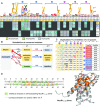The convergent xenogeneic silencer MucR predisposes α-proteobacteria to integrate AT-rich symbiosis genes
- PMID: 36007892
- PMCID: PMC9410896
- DOI: 10.1093/nar/gkac664
The convergent xenogeneic silencer MucR predisposes α-proteobacteria to integrate AT-rich symbiosis genes
Abstract
Bacterial adaptation is largely shaped by horizontal gene transfer, xenogeneic silencing mediated by lineage-specific DNA bridgers (H-NS, Lsr2, MvaT and Rok), and various anti-silencing mechanisms. No xenogeneic silencing DNA bridger is known for α-proteobacteria, from which mitochondria evolved. By investigating α-proteobacterium Sinorhizobium fredii, a facultative legume microsymbiont, here we report the conserved zinc-finger bearing MucR as a novel xenogeneic silencing DNA bridger. Self-association mediated by its N-terminal domain (NTD) is required for DNA-MucR-DNA bridging complex formation, maximizing MucR stability, transcriptional silencing, and efficient symbiosis in legume nodules. Essential roles of NTD, CTD (C-terminal DNA-binding domain), or full-length MucR in symbiosis can be replaced by non-homologous NTD, CTD, or full-length protein of H-NS from γ-proteobacterium Escherichia coli, while NTD rather than CTD of Lsr2 from Gram-positive Mycobacterium tuberculosis can replace the corresponding domain of MucR in symbiosis. Chromatin immunoprecipitation sequencing reveals similar recruitment profiles of H-NS, MucR and various functional chimeric xenogeneic silencers across the multipartite genome of S. fredii, i.e. preferring AT-rich genomic islands and symbiosis plasmid with key symbiosis genes as shared targets. Collectively, the convergently evolved DNA bridger MucR predisposed α-proteobacteria to integrate AT-rich foreign DNA including symbiosis genes, horizontal transfer of which is strongly selected in nature.
© The Author(s) 2022. Published by Oxford University Press on behalf of Nucleic Acids Research.
Figures









Similar articles
-
Ancestral zinc-finger bearing protein MucR in alpha-proteobacteria: A novel xenogeneic silencer?Comput Struct Biotechnol J. 2020 Nov 19;18:3623-3631. doi: 10.1016/j.csbj.2020.11.028. eCollection 2020. Comput Struct Biotechnol J. 2020. PMID: 33304460 Free PMC article. Review.
-
The zinc-finger bearing xenogeneic silencer MucR in α-proteobacteria balances adaptation and regulatory integrity.ISME J. 2022 Mar;16(3):738-749. doi: 10.1038/s41396-021-01118-2. Epub 2021 Sep 28. ISME J. 2022. PMID: 34584215 Free PMC article.
-
The Ros/MucR Zinc-Finger Protein Family in Bacteria: Structure and Functions.Int J Mol Sci. 2022 Dec 8;23(24):15536. doi: 10.3390/ijms232415536. Int J Mol Sci. 2022. PMID: 36555178 Free PMC article. Review.
-
A Novel AT-Rich DNA Recognition Mechanism for Bacterial Xenogeneic Silencer MvaT.PLoS Pathog. 2015 Jun 11;11(6):e1004967. doi: 10.1371/journal.ppat.1004967. eCollection 2015 Jun. PLoS Pathog. 2015. PMID: 26068099 Free PMC article.
-
Xenogeneic Silencing and Bacterial Genome Evolution: Mechanisms for DNA Recognition Imply Multifaceted Roles of Xenogeneic Silencers.Mol Biol Evol. 2021 Sep 27;38(10):4135-4148. doi: 10.1093/molbev/msab136. Mol Biol Evol. 2021. PMID: 34003286 Free PMC article. Review.
Cited by
-
Quantitative Determination of DNA Bridging Efficiency of Chromatin Proteins.Methods Mol Biol. 2024;2819:443-454. doi: 10.1007/978-1-0716-3930-6_20. Methods Mol Biol. 2024. PMID: 39028518
-
Intracellular common gardens reveal niche differentiation in transposable element community during bacterial adaptive evolution.ISME J. 2023 Feb;17(2):297-308. doi: 10.1038/s41396-022-01344-2. Epub 2022 Nov 24. ISME J. 2023. PMID: 36434281 Free PMC article.
-
Rok from B. subtilis: Bridging genome structure and transcription regulation.Mol Microbiol. 2025 Feb;123(2):109-123. doi: 10.1111/mmi.15250. Epub 2024 Mar 21. Mol Microbiol. 2025. PMID: 38511404 Free PMC article. Review.
-
Identification, characterization and classification of prokaryotic nucleoid-associated proteins.Mol Microbiol. 2025 Mar;123(3):206-217. doi: 10.1111/mmi.15298. Epub 2024 Jul 22. Mol Microbiol. 2025. PMID: 39039769 Free PMC article. Review.
-
MucR protein: Three decades of studies have led to the identification of a new H-NS-like protein.Mol Microbiol. 2025 Feb;123(2):154-167. doi: 10.1111/mmi.15261. Epub 2024 Apr 15. Mol Microbiol. 2025. PMID: 38619026 Review.
References
-
- López-García P., Moreira D.. Cultured Asgard archaea shed light on eukaryogenesis. Cell. 2020; 181:232–235. - PubMed
-
- Lane N. How energy flow shapes cell evolution. Curr. Biol. 2020; 30:R471–R476. - PubMed
-
- Brunk C.F., Martin W.F.. Archaeal histone contributions to the origin of eukaryotes. Trends Microbiol. 2019; 27:703–714. - PubMed
Publication types
MeSH terms
Substances
LinkOut - more resources
Full Text Sources
Molecular Biology Databases
Miscellaneous

